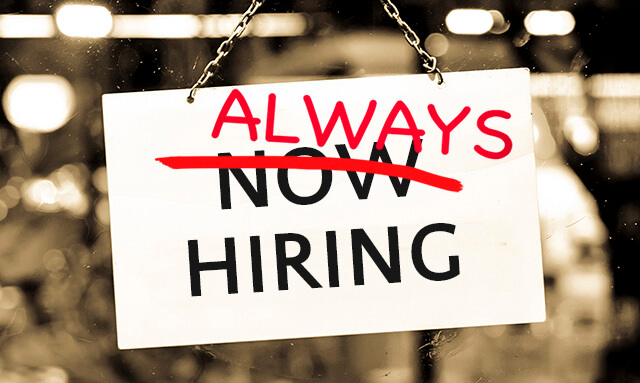Now is the Time for a Customer Service and Sales Culture Change
By: Harry J. Friedman

In the fall of 1980 I started The Friedman Group. I was 28 years old and had a lot to say about retail selling. This, of course, is according to me, thank you very much. I am not going to bore you with the details of our company with its highs and lows over the years, but we are not the same, not by a country mile.
Today I would characterize our company as an organization whose mission is to facilitate cultural change from low to high performance by individuals on the selling floor, regardless of the type of store.
I just got back from a trip to New York visiting with a few large retailers about their business and goals for their upcoming year. One of the retailers I visited with is a 5th avenue biggie, they have been around for a long time, very famous indeed. Here is my story.
I went with my sales manager and we arrived early to shop the store. From the moment we entered the store I had the feeling we stepped back in time. The mood and tempo was way off. Absolutely no energy… anywhere. Even the mannequins weren’t smiling. Having some reasonable powers of observation I could tell that there was no organization to the selling floor. Salespeople were free to talk or not talk to people that walked in. They could clump together or hide behind displays. Clearly, it didn’t matter to someone.
Our first encounter started with a “are you finding everything all right?” I did want to respond with “No we were looking for a professional salesperson with a good opening line” but alas I didn’t. Our luck continued as we passed by 3 or 4 more salespeople putting things away. A few moments later a gentleman who had worked in this store forever looked me up and down and said “We have some specials over there and a special sale rack over here.” Nice. Apparently I was not qualified to have a presentation made to me.
This organization is a pure and simple a merchandise driven business. They celebrate their wonderful offerings and hold in high esteems the traditions, culture and visual merchandising of years of being in business. One thing for sure is, they have no clue on how to run a sales floor. Do they care? Or do they just not know what is possible?
In my interview with the head of training it was all confirmed. It seemed like everyone had NO CLUE. She did let me know that they paid commission, and had metrics of all sorts but it just didn’t seem like she knew how to use them.
Because she did believe there wasn’t an issue, our conversation was short lived. Ya know it’s kind of funny, I have never had any luck talking to retailers who are happy with their business.
Fast forward to the next day. Another visit this time with a national retailer with over 500 stores. I met with the head of training again. She was very intelligent and had some grasp on what could be. She was the only employee in the training department…oh my. The company has a very simple philosophy. Keep payroll to a minimum and cut it even more when sales are off. They are an apparel company with about 3,000 sq. ft. stores with 3 staff on duty. Hourly wages, no extras, and hold the productivity please. The whole thing is kind of fun really. I know from experience we can help this company achieve some incredible sales increases and cultural change. Then she held up some Kryptonite regarding the hiring of outside training companies (she didn’t like to do that) and our meeting was over.
Back in Los Angeles I was working together with an advertising company on a simple premise of why would you bring more people into your store that you are not going to convert.
They have a very famous local client they wanted me to meet. He is on the radio and television more than you can even imagine. We chit chat for a while and I asked him a few questions about the business. Ladies and gentlemen let me tell you, we have an operator here. He was all about the productivity of his salespeople. He quoted average sale, conversion rate, etc. I then looked over to my friends and asked them why in the world was I at this meeting (this guy already got it all). It is not that often that I have a chance to meet someone who understands the extra 25% increase in sales that can be achieved with a staff of trained salespeople. His process was clear, 4 weeks of training and if an individual doesn’t hit the numbers they go back to training to get right. WOW. Let’s just say that they have set all of the industry standards, period.
I have some quick pieces of advice that I believe many businesses can benefit from.
- Identify: Make this year the year of the individual salesperson that can meet and exceed sales goals. How many people do you have now, what’s their goal? Define the target as a percentage, “60% of them hit their goal.” It is very possible because of the decline in traffic that you might have less people on staff. Get relentless on this.
- Reward: Set up a reward system that really motivates them to go for it. But going for it doesn’t mean that your salespeople have bad manners, or in other words, are “pushy”.
- Make the Call: Don’t keep poor performers past the point of pain. Pain is 90 days for training and another 90 to start performing at an acceptable level. The sort of good news is that for the first time in a decade there are some good people looking for jobs, you can thank all the big box retailers that couldn’t make it work over the last few years for that.
- Lead by Example: If (insert name of the head of the company/department/store) can’t out sell everyone, put someone in authority that can. It is all about turning shoppers into buyers and having them want to come back again. Get sales managers on the floor who care about the customer more than the staff. Get a smile on those faces and don’t accept anything less than a “Showtime presentation”.
You can make it. But not if you’re too loose or acting like you deserve customers to buy. It’s about a company-wide cultural shift to performing at a very high level. What fun indeed.
Its tough love. And by the way, I still love you.



Leave A Comment